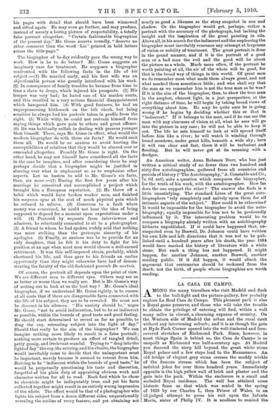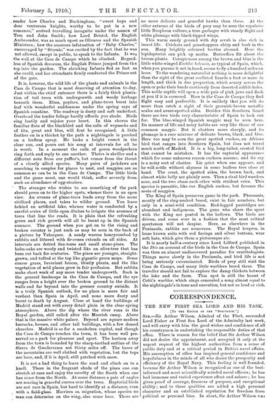LA. CASA DE CAMPO.
A liONG the many travellers who visit Madrid and flock to the bull-fight and the picture-gallery, few probably explore La Real Casa de Campo. This pleasant park is also a Royal game preserve, and those who will take the trouble to obtain the privilege of entering will find, within a wall many miles in circuit, a charming expanse of country. On the Western side of Madrid the urban and the rural meet without any intervening suburb ; and it is as though the gate at Hyde Park Corner opened into the well-timbered and fern- covered stretches of Richmond Park. Since, however, in most things Spain is behind us, the Casa de Campo is as unspoilt as Richmond was half-a-century ago. At Madrid you descend the steep hill beyond the great white stone Royal palace and a few steps lead to the Manzanares An old bridge of elegant grey stone crosses the muddy trickle of the famous stream which has been the subject of satirical jokes for over three hundred years. Immediately opposite is the high yellow wall of brick and plaster and the gate into the park. Within the enclosure is a small and secluded Royal residence. The wall has attained some historic fame as that -which was scaled in the spring of 1623 by our Charles L, then Prince of Wales, in an ill-judged attempt to press libs suit upon the Infanta Maria, sister of Philip IV. It is needless to remind the
reader how Charles and Buckingham, "sweet boys and dear venturous knights, worthy to be put in a new romanso," arrived travelling incognito under the names of Tom and John Smith ; how Lord Bristol, the English Ambassador, was as much upset as Olivares and the Spanish Ministers ; how the amorous infatuation of " Baby Charles," • encouraged by " Steenie," was excited by the fact that he was not allowed, except in public, to speak to the Infanta. It was the wall at the Casa de Campo which be climbed. Regard- less of Spanish decorum, the English Prince jumped from the top into the garden. The shrieking Infanta fled as fast as she could, and her attendants firmly conducted the Prince out of the gate.
It is, however, the wild life of the plants and animals in the Casa de Campo that is most deserving of attention to-day. Just within the chief entrance there is a fairly thick planta- tion of tall trees with undergrowth and weedy herbage beneath them. Elms, poplars, and plane-trees burst into leaf with wonderful suddenness under the spring rays of Spanish sunshine. The roadway is dusty and soft underfoot.
• Overhead the tender foliage hardly affords you shade. Birds sing lustily and rejoice your heart. In this chorus the • familiar flute of the blackbird and the calls of wrynecks and of tits, great and blue, will first be recognised. A little • further on in a thicket by the path a nightingale is perched on a leafless spray. He looks a bright russet in the clear sun, and pours out his song at intervals for all he is worth. In a moment the calls of green woodpeckers ring forth and reply to one another. Theirs is shriller and a different note from our yaffier's, but comes from the throat of a closely allied species. Many pairs of jackdaws are searching in couples for places to nest, and magpies are as common as can be in the Casa de Campo. The little birds and the game must, one would think, suffer severely from such an abundance of egg-stealers.
The stranger who wishes to see something of the park should press on to the higher spots, whence there is an open view. An avenue of plane-trees leads away from the more
• civilised places, and takes to wilder ground. You leave behind an artificial lake, whence water is conducted by a careful series of little open ditches to irrigate the avenues of trees that line the roads. It is plain that the refreshing green and rich growth will all be burnt up in the Spanish summer. The ground when you get on to the rising and broken country is just such as may be seen in the back of a picture by Velazquez. A sandy warren honeycombed by rabbits and littered with fir-cones extends on all sides. At intervals are dotted ilex-trees and small stone-pines. The holm-oaks are woody and twisted like an olive-tree that has been cut back for centuries. The pines are younger, straight- grown, and tufted at the top like gigantic green mops. Some coarse grass, luxuriant broom, thistly plants, and the like vegetation of arid places grow in fair profusion. But rabbits make short work of any more tender undergrowth. Such is the general landscape in the Cam de Campo, and the eye ranges from a height over the broken ground to the distant walls and far beyond into the greener country outside. It is a truly Spanish outlook, for no place is more fair and verdant than Spain in April, and none more dusty and burnt to death by August. Close at hand the buildings of Madrid stand out with every detail plain in the clear spring atmosphere. Above the dip where the river runs is the
• Royal garden, still called after the Moorish camp. Above that is the massive white palace. Beyond are square modern barracks, houses, and other tall buildings, with a few domed • churches. Madrid is so far a smokeless capital, and though the Cam de Campo touches the town, it has been well pre- served as a park for pleasure and sport. The horizon away from the town is bounded by the sharp-toothed outline of the Sierra de Guadarrama not thirty miles off. The bases of the mountains are well clothed with vegetation, but the tops are bare, and, if it is April, still patched with snow.
It is not a bad thing to leave the road and climb on to a knoll. There in the fragrant shade of the pines one can stretch at ease and enjoy the novelty of the South when one has Come from the North. At some distance a pair of eagles are soaring in graceful curves over the trees. Raptorial birds are not rare in Spain, but bard to identify at a distance, even with a field-glass. Harriers on migration, whose species no man can determine on the wing, also come here. There are no more delicate and graceful hawks than these. At the other extreme of the birds of prey may be seen the repulsive little Neophron vulture, a true garbager with steady flight and white plumage with black-tipped wings.
This warm sandy• ground with dry scrub is also rich in insect life. Crickets and grasshoppers chirp and bask in the sun. Many brightly coloured beetles abound. Here the lepidopterist can pick up moths. Butterflies flit about the broom-plants. Conspicuous among the brown and blue is the little white-winged Euckla belemia, so typical of Spain, which, when you pursue it net in hand, seems to fly a hundred miles an hour. To the wandering naturalist nothing is more delightful than the sight of the great ocellated lizards a foot or more in length, and thick in due proportion, which scurry across the open or poke their heads cautiously from deserted rabbit-holes.
This noble reptile will open a wide pair of pink jaws and dash at you if it is cornered. Here in the Casa de Campo they find flight easy and preferable. It is unlikely that you will do more than catch a sight of their greenish-brown metallic scales and azure-spotted sides. Besides this Southern lizard there are two birds very characteristic of Spain to look out for. The blue-winged Spanish magpie may be seen here. Its manner of life and noisy habits are very like those of our common magpie. But it chatters more sharply, and its plumage is a rare mixture of delicate brown, black, and blue. Here too may be seen the great spotted cuckoo, an African bird that ranges into Southern Spain, but does not travel much north of Madrid. It is a big, long-tailed, crested bird that cannot be mistaken. It has the raptorial appearance which for some unknown reason cuckoos assume, and its cry is a noisy sort of chatter. Lie quiet when one appears, and he will settle without shyness in some leafless tree close at hand. The crest, the spotted sides, the brown back, and almost white belly are plainly seen. Then a rival bird wanders near, and the two chase each other with strident cries. This species is parasitic, like our English cuckoo, but favours the nests of magpies.
The King of Spain preserves game in the park. Pheasants, mostly of the ring-necked breed, exist in fair numbers, but only in a semi-wild condition. Red-legged partridges are abundant and indigenous. The guns who share the sport with the King are posted in the hollows. The birds are driven, and come over in a fashion that the most critical sportsman will not despise. Here, as elsewhere in the Peninsula, rabbits are numerous. The Royal keepers, in loose brown suits with red facings and silver buttons, wear soft hats, which give them a picturesque air.
It is nearly half-a-century since Lord Lilford published in the Ibis an account of the birds in the Cam de Campo. Spain was then an almost undiscovered paradise for ornithologists.
Things move slowly in the Peninsula, and bird life is not being seriously exterminated. Birds of prey still visit the Casa de Campo, and many little warblers breed there. The traveller should not fail to explore the damp thickets between the lake and the farm. This spot is still the haunt of Cetti's warbler. which sings concealed a song almost equal to the nightingale's in tone and execution, but not so loud or rich.











































 Previous page
Previous page